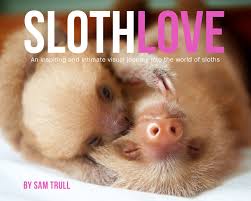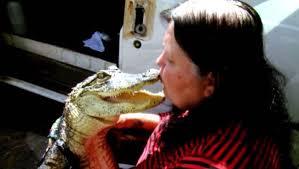Intimate Journey Into the World of Sloths
Sam Trull, Sloth Love
 Most every social media butterfly has seen at least one cute video of a sloth (If not, check out our Facebook page!). These litter critters are so cute, that many people want one as a pet. However, sloths are a wild animal and are illegal to own.
Most every social media butterfly has seen at least one cute video of a sloth (If not, check out our Facebook page!). These litter critters are so cute, that many people want one as a pet. However, sloths are a wild animal and are illegal to own.
Photographer Sam Trull says she "went to Costa Rica for the primates but stayed for the sloths." She has the lowdown on sloths, and she says people think they're slow. However, she says "they can be fast when they want to and their nails are pretty scary too."
Sam tells us that sloths belong to the xenarthran family and are most closely related to armadillos and anteaters. They are an arboreal mammal and live solely in the trees and can't live without them. As a result, they wouldn't make great pets anyway as they couldn't live in a house.
Sloths only eat leaves, and in fact, three-toed sloths are not found in captivity (zoos, etc.) outside of their habitat country because they wouldn't survive. They get too stressed out and no one can get their diets correct. You can, however, find some two-toed sloths in zoos. These sloths can be extremely dangerous and have a pretty bad bite.
So how can you tell when a sloth is stressed out when they have a permanent smile on their face? That is the hard part!
When Sam first came to Costa Rica, she started working with an organization called, "Kids Saving the Rain Forest." They also have a wildlife rescue center there and this is where Sam first fell in love with sloths.
 When Sam first started working with sloths, she realized that there was such a great need to study and learn more about them. They also need to figure out how to release a "hand-raised" sloth and to monitor them upon their release into the wild. While some two-toed sloths in zoos have lived into their forties, the best guess for their lifespan in the wild is around 20 years.
When Sam first started working with sloths, she realized that there was such a great need to study and learn more about them. They also need to figure out how to release a "hand-raised" sloth and to monitor them upon their release into the wild. While some two-toed sloths in zoos have lived into their forties, the best guess for their lifespan in the wild is around 20 years.
In August of 2014, Sam co-founded the Sloth Institute Costa Rica whose vision is to enhance and expand scientific knowledge about sloths to assure their global conservation and preservation.
Sam shares intimate portraits of these captivating and endearing animals from her unique perspective as their protector, adopted mother and friend in her book, "SLOTHLOVE."
Visit Website
Always Know Where Your Dog or Cat Is
Sebastian Langton, Pod2
 Sebastian Langton created the world's smallest GPS pet tracker. A small pod the size of a wine cork is all that's needed to find your pet most anywhere in the world. The Pod2 is also capable of setting boundaries and monitoring activity.
Sebastian Langton created the world's smallest GPS pet tracker. A small pod the size of a wine cork is all that's needed to find your pet most anywhere in the world. The Pod2 is also capable of setting boundaries and monitoring activity.
The Pod2 is small and light. It is for pet parents who want to protect their animals and find them when they go missing. It is done with a downloadable App that controls the Pod2 device. This gives you the ability to locate your pet on demand at any time.
It will also give you the ability to create a virtual fence around your property, so that when your animal escapes, you will get an alert. The lights on the Pod will also start flashing while on your pet. Sebastian tells us of a cat, that when his Pod started flashing (meaning he was going out of bounds), he would return home for treats.
You can also find out a little bit more about the secret lives of your pet through their activities and adventures that are recorded on the Pod2. This will let you know if your pet needs more or less activity in their day. You can also record their adventures. So if you have one of those cats that goes out all night long and you're interested in where he goes and who's feeding him, you can press record and see exactly what he's up to.
The Pod2 comes with a charging dock and two batteries so you can always keep it on your pet's collar. This means you can have one charging while your pet is wearing the other, so your pet is never without it while it is being charged.
 When Pet Food Is Medicine -Dr. Debbie
When Pet Food Is Medicine -Dr. Debbie
Proper pet nutrition is more than just diet choices for the healthy pet. It's even more important to properly feed the sick pet or those with chronic diseases. What you put in your pet's food bowl can help, or harm, his ability to cope with illness.
Peek into your average veterinary office and you'll likely find one or more brands of therapeutic diet foods created to manage pet specific pet health conditions. Veterinarians prescribe therapeutic diets to help pets with kidney disease, diabetes, pancreatitis, weight loss or heart disease. Special digestive diets may focus on hypoallergenic ingredients, fiber content or fat levels. Some diets prevent or dissolve mineralized stones in the urinary bladder. There are even diets to keep the spring in your arthritic dog's step and diets to aid in treating pets with cancer.
The grandfather of veterinary nutrition was Dr. Morris who in 1940 designed a diet to improve longevity of his dog, Buddy, who was a seeing-eye dog battling kidney disease. His efforts led to the introduction to Hill's K/D diet, a favorite diet used today for dogs and cats with kidney dysfunction. Today many more diets and conditions are addressed by companies such as Science Diet, Royal Canin, Purina and Iams.
As a veterinarian I recognize the value that therapeutic diets lend to managing my patients' health. But my strongest testament to their value is as a doggie momma who fed a therapeutic diet to my own dog, Magnum.
My Labrador Magnum suffered from food allergies with frequent facial skin infections, bad skin odor, scratching and unpleasant gastrointestinal signs with diarrhea and flatulence. After several diet trials with various hypoallergenic diet approaches, he then thrived on a rabbit based therapeutic diet by Royal Canin. His doggie kisses were sweeter smelling, he was content and he wasn't a walking gaseous explosion anymore.
But be prepared to dig deeper in your wallet for therapeutic diets. The research behind these foods will cost the consumer more than average pet foods. Just look at the example of Magnum's food. This diet runs $86 for a 25-pound bag of dry food. This sure isn't cheap. But the investment can pay off in lower medical costs and fewer veterinary visits, justifying the additional cost. In Magnum's case, we are able to avoid continued treatment of skin infections, thereby avoiding medication use and he is spared incessant itching.
 Some pet owners turn to home cooked diets in order to avoid the costs of therapeutic diets. Without guidance and veterinary nutrition analysis, pet owners may risk shortchanging their pet's nutrition. One research study identified that over 90-percent of home prepared diets for sick pets failed to be nutritionally adequate. Quality ingredients aren't cheap and a well-produced home cooked diet often ends up costing far more to prepare than commercially produced therapeutic diets.
Some pet owners turn to home cooked diets in order to avoid the costs of therapeutic diets. Without guidance and veterinary nutrition analysis, pet owners may risk shortchanging their pet's nutrition. One research study identified that over 90-percent of home prepared diets for sick pets failed to be nutritionally adequate. Quality ingredients aren't cheap and a well-produced home cooked diet often ends up costing far more to prepare than commercially produced therapeutic diets.
If your veterinarian recommends nutritional management with a therapeutic diet, discuss all the options with your doctor. Inquire about different brands and sizes of food packages available, as many options are available. Get your money's worth on these diets by following your veterinarian's recommendations. Avoid mixing therapeutic diets with regular foods. This only hinders your pet's results and give you a false sense of saving money by making the food last longer.
As for Magnum, I chose to feed him his therapeutic diet and avoid popping pills into him. That's my gauge of a therapeutic diet success - food that serves like medicine in the doggie bowl, but without the hassles.
Featured veterinarian known as "Dr. Debbie" on national pet radio program, Animal Radio. Ebook author of "Yorkshire Terriers: How to Be Your Dog's Best Friend"; "Pugs: How to Be Your Dog's Best Friend"; "Mini Schnauzers: How to Be Your Dog's Best Friend"; and "Shih Tzu: How to Be Your Dog's Best Friend." Dr. Debbie's books.
Visit Website
5 Pets That Are Illegal To Own
Robert Semrow, Animal Radio Listomania
 Ok, I know what you are thinking… If they are pets they are certainly legal. Well, that's not necessarily the case depending on the state or city that you live in. There can be legal issues for having common pets that exist in different states or cities.
Ok, I know what you are thinking… If they are pets they are certainly legal. Well, that's not necessarily the case depending on the state or city that you live in. There can be legal issues for having common pets that exist in different states or cities.
Let's start with Ferrets. In several states and large cities (Including California, Hawaii, New York City and Dallas to name a few), ferrets are illegal and if caught, you could face fines up to $200K or even prison time. That's right, ferrets; the court jesters of the animal world, filled with curiosity and enough cuteness to power any world are illegal in certain places. Some states allow you to have them as pets, but require additional filings and you must meet certain requirements.
Next up is Gerbils. If you are in California, you may be surprised to know that your state does not allow gerbils as a pet as they are deemed to pose a threat to the eco system. These tiny palm-sized pets are common household pets in many areas of the U.S. as they are easy to care for and handle, while also being social creatures.
 Next is the Hedgehog - No, I'm not talking about the video game version but the super cute, albeit very spiny hedgehog. These fascinating and easy to care for animals have very simple needs and are quite adaptable. They are interactive, yet, if handled improperly can use their quills to get their point across. Yes, I went there. The bigger concern is that there are certain states and municipalities who deem them illegal as pets and/or have severe restrictions including California, Georgia, Hawaii, Pennsylvania and more.
Next is the Hedgehog - No, I'm not talking about the video game version but the super cute, albeit very spiny hedgehog. These fascinating and easy to care for animals have very simple needs and are quite adaptable. They are interactive, yet, if handled improperly can use their quills to get their point across. Yes, I went there. The bigger concern is that there are certain states and municipalities who deem them illegal as pets and/or have severe restrictions including California, Georgia, Hawaii, Pennsylvania and more.
Let's not forget that there are number of fish and snakes that are also illegal to own in various states through the United States. It is remarkable the variety of these species that are found legally in the homes of people in some states, while not allowed in the homes in other states.
 Finally, I would be remiss, to not bring up the troubling movement to ban certain breeds of dogs and cats in cities and states across the country. From Bengal Cats to Pit Bull Dogs, traditional pets are increasingly under the scrutiny of the legal system.
Finally, I would be remiss, to not bring up the troubling movement to ban certain breeds of dogs and cats in cities and states across the country. From Bengal Cats to Pit Bull Dogs, traditional pets are increasingly under the scrutiny of the legal system.
While this list could go on for many days, I bring it up as a reminder that while you have rights, states and cities have laws. I'm not saying these laws or regulations are right or wrong. I am saying consider this when you are looking at adopting a new animal family member and remember that you are responsible to know the laws where you live in regards to your animal family members. Don't make the mistake of assuming anything or you may find yourself in big trouble and your pet confiscated or worse.
Share your pet legal stories on our Animal Radio Facebook Page.
Visit Website
Animal Radio News - Lori Brooks
 Doggy DNA Nabs Poop Offenders
Doggy DNA Nabs Poop Offenders
A luxury apartment community near Grand Rapids, Michigan used DNA technology as a way to sniff out dog owners who fail to pick up their pets' poop. The complex asked dog owners to swab their pet's mouth so they could build a DNA database that allows it to identify residents who ignored its strict cleanup policy. The management company contracted with a company to collect DNA samples of each dog in the development. It's estimated that about 60-percent of the apartment residents own a pet. From now on, if a doggie do-do pile is found on the grounds, a sample will be matched to the offending dog and owner. Violators will face a $350 fine.
We Finally Know Why Cats Love Boxes!
Anyone who has spent time with cats knows how they love to find their way inside boxes, but there's actually a scientific explanation behind the attraction between cats and boxes. According to the folks at WIRED, cats are naturally wired to like small, closed in spaces; it's their natural animal instinct for safety and security. Also, a cat, entering an enclosed space has an adaptive coping mechanism that serves to reduce its stress and give it time to sort things out. And, there is also a physiological reason your cat prefers small area like boxes: cats temperatures run a bit cooler than humans so cats prefer a warmer environment. Seeking out a snuggly box or contained area allows it a cats on body heat to warm up a small space and keep it toasty warm.
 Woman Gained Support To Keep Pet Alligator
Woman Gained Support To Keep Pet Alligator
A community came together in support of a Florida woman who was fighting to keep her pet alligator that she had been been a mother to for over 10 years. The Florida Fish and Wildlife Conservation Commission said she would have to give up her alligator because of a licensing issue, so she set up a petition, asking the agency to allow him to stay in her care. A special Facebook page was also set up to gain support for him, who by the way was more than six feet long. According to authorities, a pet alligator that size must live on two-and-a-half acres or more of land. His owner said he never lived in the wild and had already developed sensitivity to sunlight by the time she rescued him.
Average Size of Dogs Are Shrinking
A study from the University of Sydney said the average size of a dog was shrinking because more pet owners preferred smaller dogs as companions. Researchers analyzed nearly three decades of registrations to the Kennel Club, a UK based dog welfare organization. They found dog lovers are also increasingly opting for bulldogs and pugs because of their large heads. The popularity is said to be driven partly by their big eyes and chubby cheeks that trigger the same 'caretaking behavioral responses' that adults have towards babies. The study found the average height of a dog in 2010 was 47.7cm or almost 19 inches. Ten years earlier, a typical dog stood at close to 20 inches tall. The lead researcher said they also found that the demand for smaller dogs increased every year from 1986.
 Cat's Got More Than Your Tongue
Cat's Got More Than Your Tongue
A pet feline in New Zealand had been stealing men's underwear and socks from other people's homes. In just 2 months, the 6-year-old cat acquired 11 pairs of underwear and more than 50 pairs of socks. The owner said she put notes in every mailbox on her street to warn her neighbors. One day, her cat came in from being outdoors, very motherly carrying a sock like it was a kitten.
Pet Cemeteries Popular in China
Pet cemeteries have become popular in China, with owners paying a lot of money to bury their animals. It costs between $50 and $1,800 for an owner to buy their pets a plot in Chinese pet cemeteries. Rows of tombstones at one cemetery bear the names of pets along with flowers, toys, food and even calcium pills and chew bones were seen placed beside them. Pet owners who wish to give their animals a more formal send off can opt to bury their animal under the roots of trees or in a single grave. They can also opt for cremation.
 Listen to the entire Podcast of this show (#1221)
Listen to the entire Podcast of this show (#1221)





